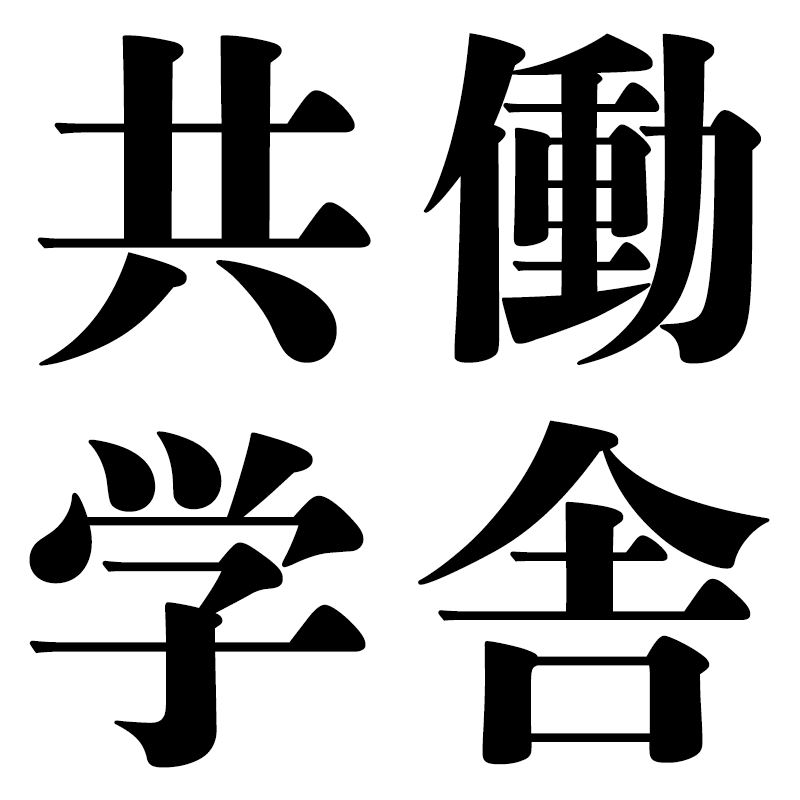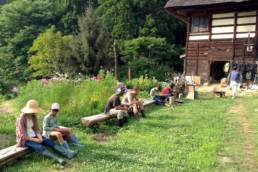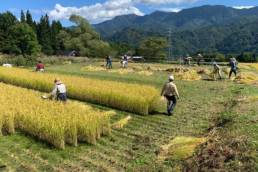All Kyodogakusha houses are located in villages in the countryside. We are mainly engaged in agriculture and handicraft.
We believe that it is best to live close to nature in order to seek better living possibilities and to experience the joys and the hardships of life.
There are four locations in Japan:Two in Nagano;two in Hokkaido.
Shinshu(Nagano) Kyodogakusha
This was starated in August,1973 at Otari village in the northwest part of Nagano Prefecture. It is one hour from the Japan Sea and is located along the Hime River.The building are spread into three places. The main building is in
Tateya hamlet, which is situated 850 meters above sea level.
The Bakery is in Chikuni hamlet, and the third is in Maki hamlet,900meters above sea level. where all former residents have emigrated.
Our goal is to be self-reliant. We thus try to produce food we need by ourselves in the first places. We grow rice, vegetables, mushrooms, flowers, and raise silkworms, cattle, pigs, goats and chicken. We also produce bread, cakes and miso.Almost all food other than marine products are somehow produced by ourselves. Planting cedar trees at Maki hamlet is also an important job.
Hokkaido Neiraku Farm
This farm was started in June,1977 at Neiraku in Obira machi in Rumoi-gun. It is a 34 hectale hill-land in the middle of a rice paddy region about 15Kms east from the Japan Sea and west of Asahikawa.
This land had never before been utilized by other people, but the member are opening the land so that they can grow vegetables and raise liverstocks such as pigs, sheep, goats and chicken, as well as to plant trees and bread fish.
Handspun yarn is also sent to other Kyodogakusha houses as material for weaving and knitting.
Hokkaido Shintoku Farm
The Shintoku Farm is situated between the Daisetsu mountain range and the Hidaka mountain range, and west of Obihiro(about one hour) and near Karikachi Pass.
The 45 hectare slope of Mt.Gyunyu, on the outskirts of Shintoku machi, is being used mainly for raising cattle and small animals, Ham, bacon, butter and cheese are also produced here.
We sell vegetables produced here directly to customers, cooperating with the farmers in town who do not use pesticides nor chemical fertilizers.
The winter in Shinshu, Nagano and Hokkaido is long.
There are five month’s time when outdor work cannot be done.
During this season, as well as from spring to autumn, andin case of bad climate, the members are engaged in weaving, knitting, embroidery, making corn dolls and woodwork.
In addition to agriculture and handicraft, building houses and construction work are other important jobs at Kyodogakusha. There is always something that everybody can take part in these works and everybody has tocooperate with each other.We build our own lodgings and other necessary buildings by ouraselves. Furthermore, we manage our own water supply and sewage works, construct small dams and bridges when necessary. We try to produce and build as much as we can in order to learn the fundamental principles of independence.
We value agriculture not only because it is a necessary means for acquiring self-reliance but also because it offers us opportunities to come in touch with nature that has not been contaminated by artificial means.Agriculture today always holds in one hand the danger of destroying nature, but we try to seek a way in which all creatures, plants and animals including human beings, can continue to live by cooperating and sharing with each other.
We, therefore, think that there is no other human profession like agriculture that requires so much wisdom and that it is the most essential profession for human education.
As started above, the life at Kyodogakusha is based on productive labor work. Our classrooms are the respective places of works in the villages where the young peaople are drifting away towords the city.



